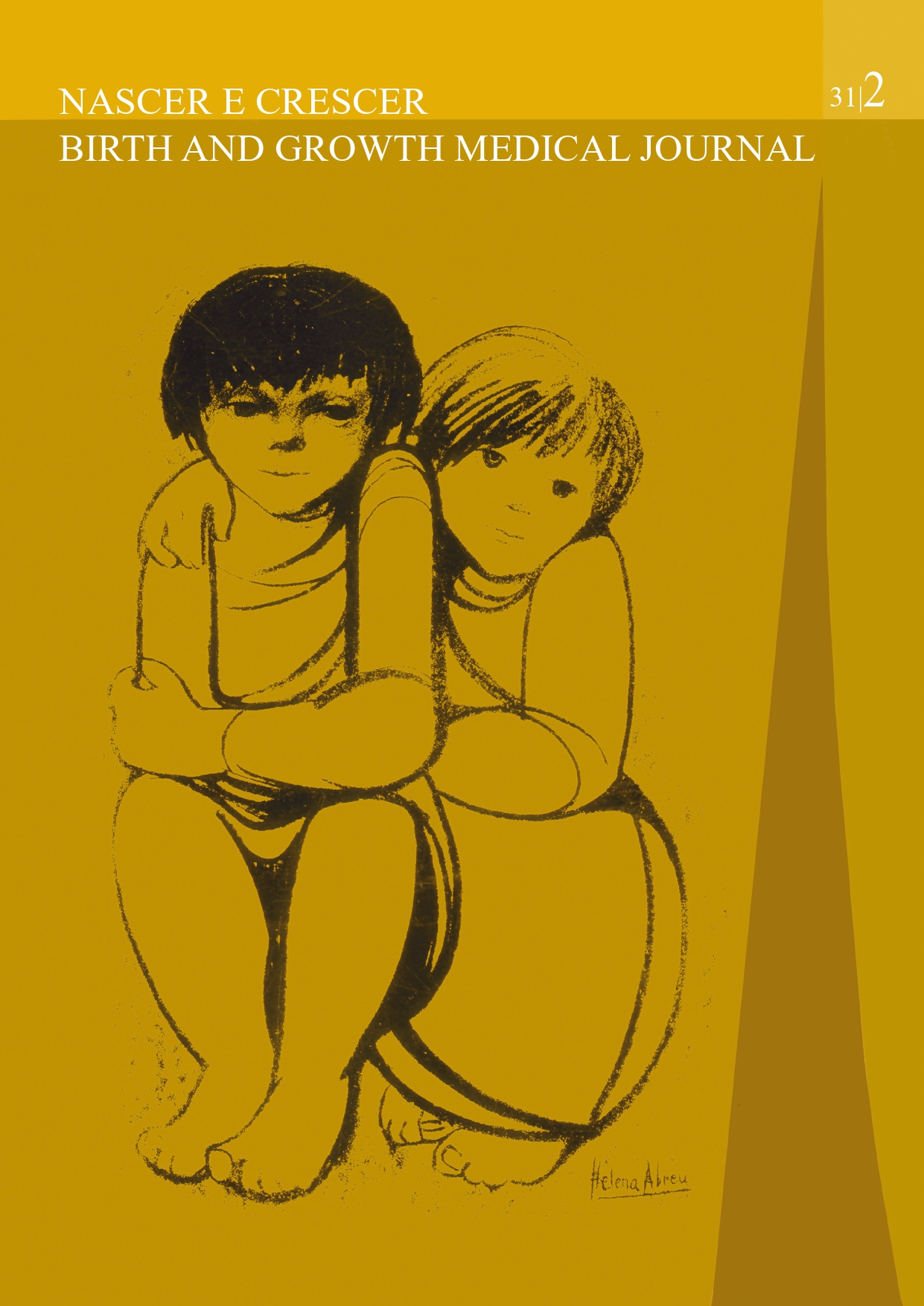Hemocultura positiva e sépsis neonatal – Casuística de cinco anos
DOI:
https://doi.org/10.25753/BirthGrowthMJ.v31.i2.23899Palavras-chave:
hemocultura, recém-nascido, sensibilidade antimicrobiana, sépsisResumo
Introdução: A sépsis neonatal continua a ser uma das principais causas de mortalidade e morbilidade neonatal. Dado que os microrganismos etiológicos responsáveis predominantes variam entre regiões e ao longo do tempo, torna-se essencial conhecer a epidemiologia local. O objetivo deste estudo foi caracterizar os doentes com hemocultura positiva e apresentação clínica compatível com sépsis internados numa Unidade de Neonatologia e identificar possíveis fatores de risco e agentes microbianos envolvidos e respetivas sensibilidades.
Métodos: Estudo retrospetivo descritivo de dados clínicos de doentes com hemocultura positiva e apresentação clínica compatível com sépsis internados na Unidade de Neonatologia de um hospital de nível II ao longo de cinco anos (2014-2018)..
Resultados: Foram identificados 73 casos de sépsis confirmados por hemocultura, 51 (69,9 %) dos quais correspondentes a recém-nascidos com baixo peso e 52 (71,2%) a recém-nascidos pré-termo. A maior parte dos casos era relativa a sépsis tardia (60; 82,2%). Os microrganismos mais frequentemente identificados foram Sthapylococcus coagulase-negativos (55; 75,3%), principalmente associados a sépsis tardia. Os principais responsáveis por sépsis precoce foram Streptococcus do Grupo B e Escherichia coli. Não foram isolados Staphylococcus aureus resistentes a meticilina. Os Sthapylococcus coagulase-negativos apresentaram elevadas taxas de resistência aos antibióticos beta-lactâmicos.
Conclusões: Os resultados obtidos documentam a epidemiologia local de sépsis neonatal, caracterizada por elevada frequência de sépsis tardia associada a microrganismos nosocomiais. Os Sthapylococcus coagulase-negativos são resistentes à maioria dos antibióticos mais frequentemente utilizados, sendo necessária a utilização de vancomicina nestes casos. É urgente implementar protocolos eficazes de prevenção e controlo de infeções nosocomiais para diminuir a incidência, mortalidade e morbilidade de sépsis neonatal e a utilização de antibióticos de largo espetro.
Downloads
Referências
Adams-Chapman I, Stoll BJ. Neonatal infection and long-term neurodevelopmental outcome in the preterm infant. Curr Opin Infect Dis 2006; 19: 290-7. https://doi.org/10.1097/01.qco.0000224825.57976.87.
Shane AL, Sánchez PJ, Stoll BJ. Neonatal sepsis. Lancet 2017; 390:1770-80. https://doi.org/10.1016/S0140-6736(17)31002-4.
Cortese F, Scicchitano P, Gesualdo M, Filaninno A, De Giorgi E, Schettini F, et al. Early and late infections in newborns: Where do we stand? A review. Pediatr Neonatol. 2016; 57(4):265-73. https://doi.org/10.1016/j.pedneo.2015.09.007.
Centers for Disease Control and Prevention. Prevention of perinatal Group B Streptococcal Disease – revised guidelines from CDC. MMWR 2010;59(No. RR-10):1-36.
Bizzarro MJ, Raskind C, Baltimore RS, Gallagher PG. Seventy-five years of neonatal sepsis at Yale: 1928–2003. Pediatrics 2005;116:595–602. https://doi.org/10.1542/peds.2005-0552.
Pokhrel B, Koirala T, Shah G, Joshi S, Baral P. Bacteriological profile and antibiotic susceptibility of neonatal sepsis in neonatal intensive care unit of a tertiary hospital in Nepal. BMC Pediatr. 2018;18:208. https://doi.org/10.1186/s12887-018-1176-x.
Graça A, Moniz C, Lito L, Salgado MJ, Guerreiro MO. Infecção Neonatal – Importância do Conhecimento da Epidemiologia Local. Acta Pediatr Port 2005;36(6): 267-72. https://doi.org/10.25754/pjp.2005.4906.
Secção de Neonatologia da SPP. Septicémia neonatal – etiologia. Estudo multicêntrico da Secção de Neonatologia da SPP. Acta Pediatr Port 1999;30(4): 299-305. https://doi.org/10.25754/pjp.1999.5488.
Vergnano S, Menson E, Kennea N, Embleton N, Russell AB, Watts T, et al. Neonatal infections in England: the NeonIN surveillance network. Arch Dis Child Fetal Neonatal Ed. 2011;96:9-14. https://doi.org/10.1136/adc.2009.178798.
Stoll BJ, Hansen NI, Sánchez PJ, Faix RG, Poindexter B, Van Meurs KP, et al. Early onset Neonatal Sepsis: The Burden of Group B Streptococcal and E.coli Disease continues. Pediatrics 2011;127: 817-26. https://doi.org/10.1542/peds.2010-2217.
Morioka I, Morikawa S, Miwa A, Minami H, Yoshii K, Kugo M, et al. Culture-Proven Neonatal Sepsis in Japanese Neonatal Care Units in 2006-2008. Neonatology 2012; 102:75-80. https://doi.org/10.1159/000337833.
Maia C, Paúl A, Mesquita J, Santos-Silva I, Negrão F, Faria D. Sépsis Neonatal – análise retrospectiva de 2004 a 2006 da Maternidade Bissaya Barreto. Saúde Infantil. 2010; 32(1):28-32.
Stoll BJ, Hansen N, Fanaroff AA, Wright LL, Carlo WL, Ehrenkranz RA, et al. Late-Onset Sepsis in Very Low Birth weight Neonates: the Experience of the NICHD Neonatal Research Network. Pediatrics 2002;110:285-91. https://doi.org/10.1542/peds.110.2.285.
Dalai R, Dutta S, Pal A, Sundaram V, Jayashree M. Is Lumbar Puncture Avoidable in Low-Risk Neonates with Suspected Sepsis? Am J Perinatol 2020. https://doi.org/10.1055/s-0040-1714397. Online ahead of print.
Aleem S, Greenberg RG. When to Include a Lumbar Puncture in the Evaluation for Neonatal Sepsis. Neoreviews. 2019;20(3):e124-e134. https://doi.org/10.1542/neo.20-3-e124.
Barreirinho MS, Guedes A, Soares P, Braga AC, Oliveira P. Sépsis Neonatal. Acta Pediatr Port. 2000;31:371-6.
Bizzarro MJ, Shabanova V, Baltimore RS, Dembry LM, Ehrenkranz RA, Gallagher PG. Neonatal Sepsis 2004-2013: The Rise and fall of Coagulase-Negative Sthaphylococci . J Pediatr 2015;166:1193-99. https://doi.org/10.1016/j.jpeds.2015.02.009.
Ramasethu J. Prevention of Health Care–Associated Infections in the NICU. NeoReviews 2020; 21(8):e546-e558. https://doi.org/10.1542/neo.21-8-e546.
Downloads
Publicado
Como Citar
Edição
Secção
Licença
Direitos de Autor (c) 2022 Adriana Ferreira, Eulália Sousa, Joaquim Freitas, Mariana Viana, Filipa Miranda, Francisco Pereira da Silva

Este trabalho encontra-se publicado com a Creative Commons Atribuição-NãoComercial 4.0.
Copyright e Direitos dos Autores
Todos os artigos publicados na Revista Nascer e Crescer – Birth and Growth Medical Journal são de acesso aberto e cumprem os requisitos das agências de financiamento ou instituições académicas. Relativamente à utilização por terceiros a Nascer e Crescer – Birth and Growth Medical Journal rege-se pelos termos da licença Creative Commons "Atribuição - Uso Não-Comercial - (CC-BY-NC)"".
É da responsabilidade do autor obter permissão para reproduzir figuras, tabelas, etc. de outras publicações.
Juntamente com a submissão do artigo, os autores devem enviar a Declaração de conflito de interesses e formulário de autoria. Será enviado um e-mail ao autor correspondente, confirmando a receção do manuscrito.
Os autores ficam autorizados a disponibilizar os seus artigos em repositórios das suas instituições de origem, desde que mencionem sempre onde foram publicados e de acordo com a licença Creative Commons.


